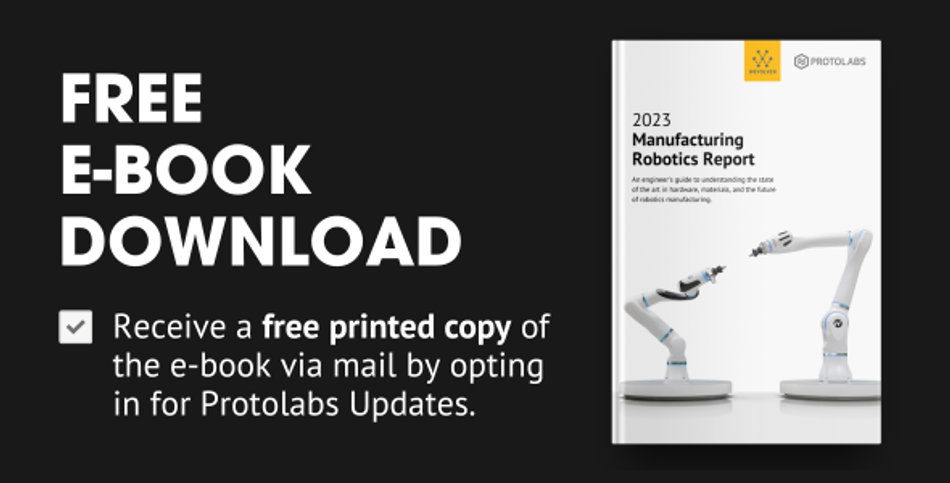The 2023 Manufacturing Robotics Report
An engineer's guide to understanding the state of the art in hardware, materials, and the future of robotics manufacturing.

Report introduction
The discussion and focus of the field of robotics have often been closely tied to its manufacturing application origins. However, over the past decade, robotics has exploded to include devices that augment surgery, assist with elderly care, lead search and rescue missions and monitor waterways. The importance of robotics is not lost on the engineering community — robotics-related content is continually the most read on the Wevolver platform. With that focus in mind, The 2023 Robotics Manufacturing Report is to enable you to be up to date and understand the complexity and depth of robotics and to help you gain specific insights into the current status of robotics manufacturing.
Over the next five chapters of the report, we will examine the core technologies that make up a robotics project and shed light on the trends and challenges in creating them.
Read the full report now.
Each week we'll release a chapter of the report. However, if you can't wait that long, you can download the full report now by entering your email address below.
Protolabs is also sending out printed versions of the e-book if you opt-in for their relevant updates in the register form below.

Understanding new materials
One of the most exciting areas of technological advancement is in materials. As the survey linked to this report found, many consider soft robotics an area with great potential. One early example of soft robotics are soft grippers, which are more flexible and can grip a wider variety of items. This makes robots able to perform even more logistic tasks. They are also able to handle delicate and perishable items. This opens up interesting opportunities in agriculture, where the interest in automation is growing fast.
Soft robotics presents new problems that need to be addressed. Materials and design need to be carefully evaluated. When developing grippers for a particular application it’s important to consider that these materials are different from other commonly used materials. This makes it especially important to know the manufacturing process used, and to be aware of their opportunities and challenges. It’s also important to approach this in an iterative way as this explores new context where robotics have not been used before. Here the ability to make small numbers of parts in many different soft materials is key. This makes iterations faster and shortens the development time. As this is new and materials are sometimes challenging, special care has to be taken when working with suppliers.
Iterative design cycles
Developing and manufacturing robots for these emerging markets presents new challenges and requires creative thinking. As with the soft robots mentioned previously, an iterative approach with a close eye on manufacturability is necessary here. A key factor for consideration is that the users will be much more diverse as will the situations the robots will be used in. The low-cost factor drives the need for more focus on keeping up with the latest manufacturing methods and to design with them in mind. Here, good support from suppliers and partners are essential as they know their methods best.
In other parts of robotics, we also see tremendous growth in advanced systems. Images, video and other data streams that can be considered complex can now be processed reliably. New legged platforms can bring the technology out in complex production settings that are not constructed with robotics in mind. IoT devices can monitor systems in new ways, and because they are small and cheap, they can be used in large numbers.
More advanced robotics systems also allow for more remote working in roles that traditionally have been onsite. This reduces staff cost and provides existing staff with a better work environment. Improvements in resource utilisation is also an opportunity as problems can be addressed by accessing the robot remotely, reducing response time and increasing up time. It can also enable cooperation between humans and robots. The robot can do the 80% that is relatively easy to automate. When necessary, it calls on the human to do the remaining 20% that is hard or impossible to automate, or to fix any problems.
Plug and play democratises development
The introduction of ecosystems of products that work together around common standards will be incredibly significant in the long term, as it was when the same thing was introduced to computer peripherals. Nowadays everyone expects that whatever they buy and plug in to their computer will just work. Plug and play has indeed fulfilled its destiny. The same thing is about to happen in robotics, automation, and IoT. The trend is moving towards a time when a task can be automated with a solution that "just plugs into" your operation. Even if this is achievable, automating complex production will always be much more complicated.
Product ecosystems will be quite practical in many production and logistics settings. This growing ecosystem of software and hardware that all work together is also a key factor in bringing new technologies to market much quicker. They make it surprisingly easy to assemble solutions. These trends together make robotics available, practical, and affordable.
On the financial side of things, we are not only seeing prices coming down, but also much more flexible ways of paying. With today's more intelligent systems, you can pay per task that the robot performs for you. This and other new robotics as a service (RaaS) implementations drastically lower the barriers to entry. This makes it possible to try robotics in more contexts and see where a good fit can be found.
So, to sum up, this report will give you key knowledge about the current state of robotics, covering opportunities in new materials, and innovative ways of designing and manufacturing robots. Trends that are expected to be significant are also discussed in this report. Examples of the wide variety of new systems that are currently being developed are also included.
This introductory chapter was written by Per Sjöborg.
The 2023 Manufacturing Robotics Report
Introduction chapter: The 2023 Manufacturing Robotics Report
The 2023 Manufacturing Robotics Report: Materials
The 2023 Manufacturing Robotics Report: Robotic Projects and Tech Specs
The 2023 Manufacturing Robotics Report: Hardware
The 2023 Manufacturing Robotics Report: Manufacturing
About the sponsor: Protolabs
Protolabs is the world’s fastest digital manufacturing source for custom prototypes and low-volume production parts. We use advanced injection moulding, CNC machining and 3D printing technologies to produce parts within days. The result is an unprecedented speed-to-market value for product designers and engineers worldwide.
Our end-to-end digital thread enables faster and more efficient product development in order to produce parts in as fast as 1 day as well as eliminating most of the time-consuming and expensive skilled labour that is conventionally required. With manufacturing facilities operating across Europe, we can balance production across multiple sites and produce parts where they are needed.
